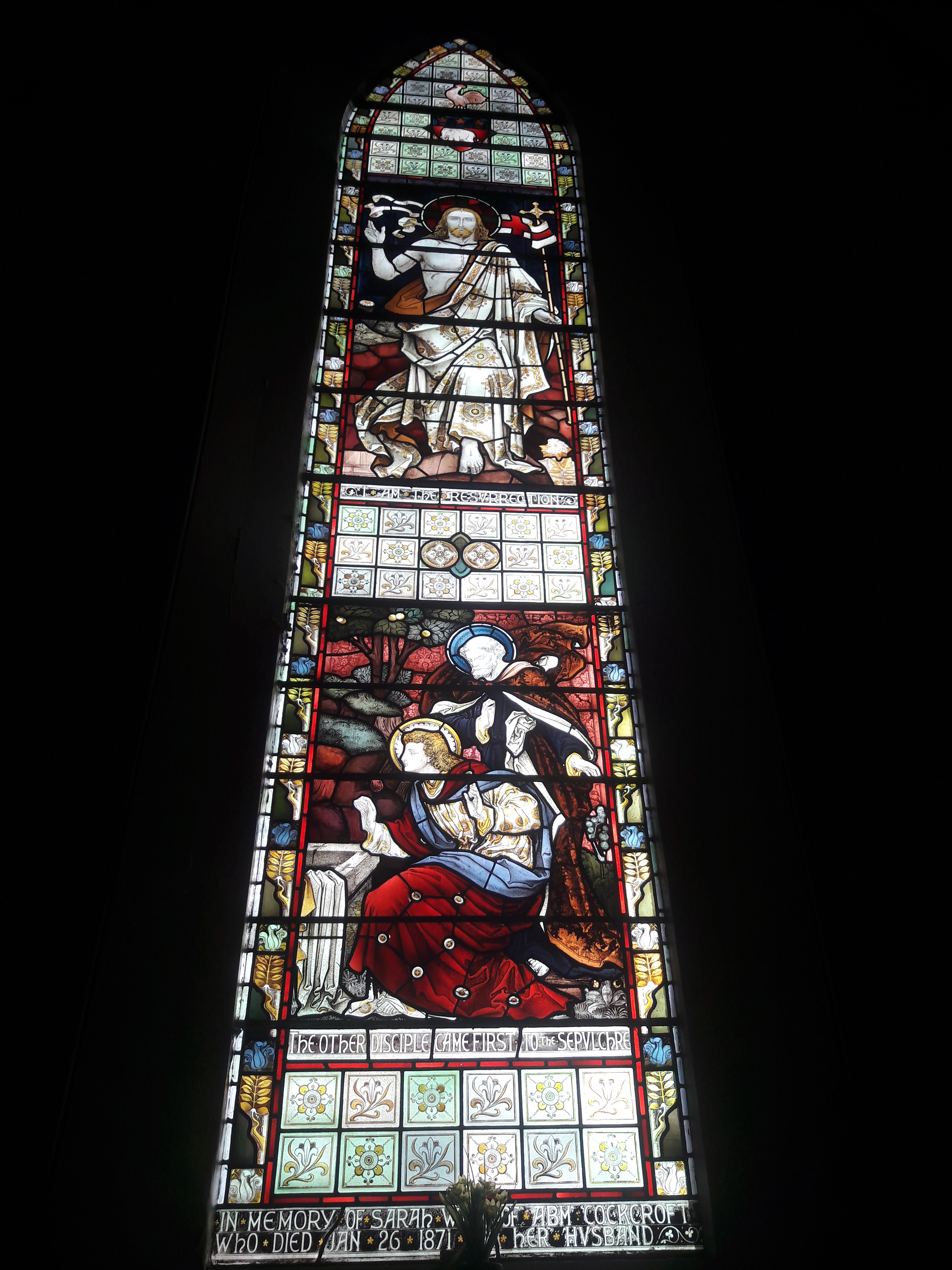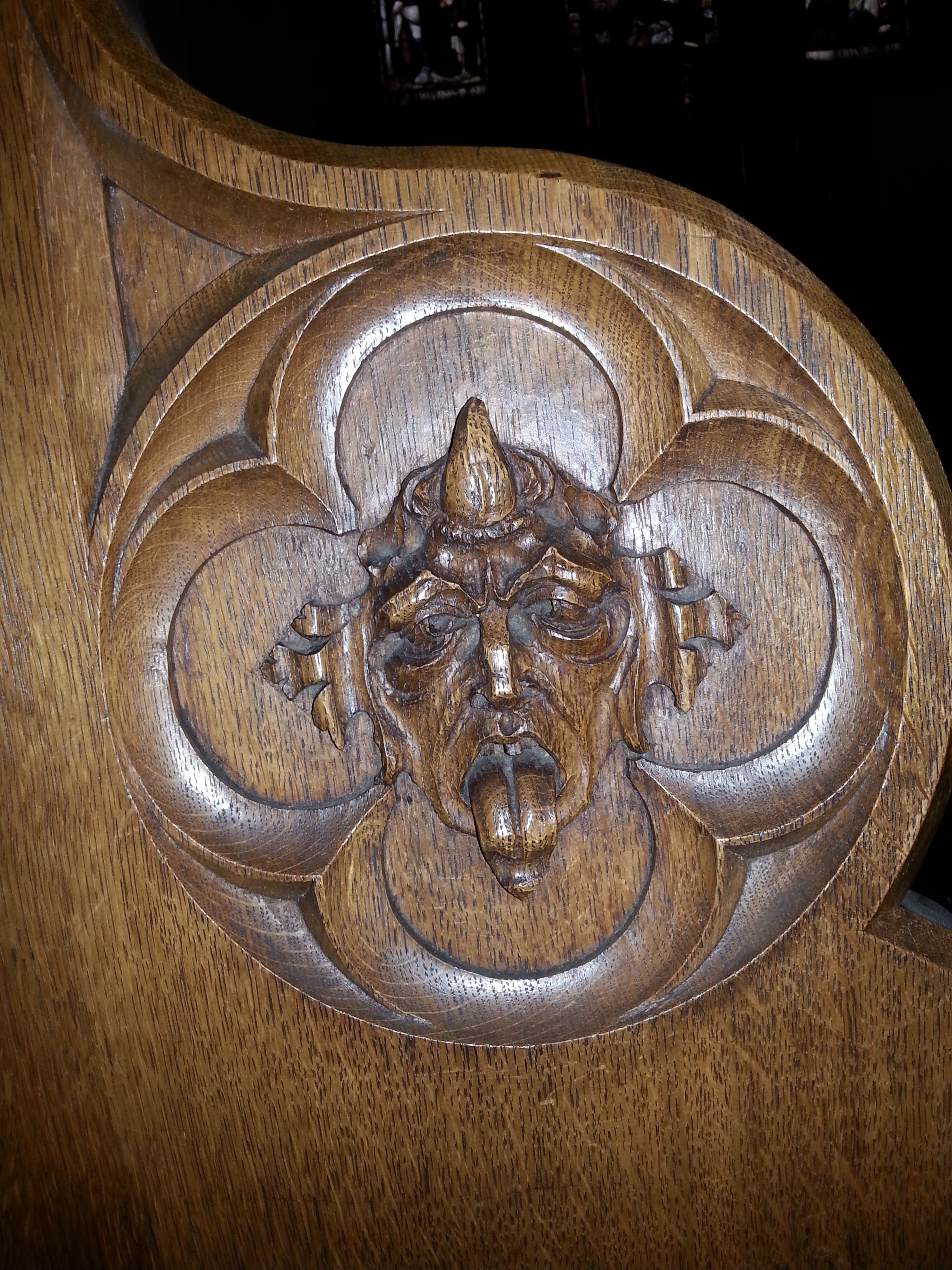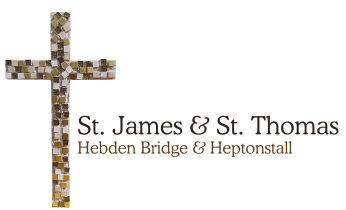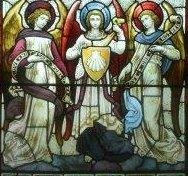Our Victorian Stained Glass
If you are a Victorian Stained Glass groupie, then our church is a must to visit. It is one of those rare churches where all the church's glass was designed and installed in one short period. All these well-documented windows are by Heaton Butler and Bayne as part of a Richard Norman Shaw restoration in the late 1870’s and early 1880’s. The designer for the chancel interior was John Aldam Heaton and our first window shows the red and green textile design Aldam Heaton used to provide curtains all round the chancel East end. A traditional ecclesiastical design that even appears in the early possessions of the Archbishop of York! Norman Shaw was a famous architect who went on to design New Scotland Yard, parts of Bradford Town Hall and had a major influence on the design of Piccadilly Circus.
If on the other hand you want to get a feel for what the congregation at the time wanted to replace their plain glass with then this glass is very well described in the Church Magazine of the time. We have used their descriptions in preparing a folder to take round as you view each window
(available in the church near the display cabinet on the north side).
This window is in the East end. The Reverend George Sowden, who carefully led his flock through the upheavals in the Church of England at that time, described the blue robes of The Blessed Virgin Mary, as “ the best glass in our church”. And it is true what they said that the glass improves with familiarity. So visit, you are most welcome.
Alterations to the church in 1980s and 1990s, when people were not so aware of the importance of our collection of windows led to the sale of some of them to Pendle Glass. We have their descriptions in great detail and we would love to discover what happened to them, perhaps bought by private collectors, or dismantled.
Upper Room Window showing three angels
Heaton, Butler and Bayne became one of the leading firms of Gothic Revival Stained glass manufacturers. They produced glass for windows of churches in Britain and the USA and for churches throughout what was then the British Empire. Examples of their work can be found in Tewksbury Abbey, Westminster Abbey, St Matthews Cathedral in Laramie, Wyoming, and also in the Cathedral of the Holy Trinity Quebec, Canada. Nearer home, Rochdale Town Hall also has many fine examples.
***********************************
A Brief History
This beautiful Parish Church, set in the heart of the Calder Valley was consecrated on 5th October 1833. The church is dedicated to St James the Great [also known as St James the Greater], and was built on land given by the Reverend James Armitage Rhodes and his wife, Mary, who owned nearby Mytholm Hall.
The request for a church was being discussed as early as 1824. Mr and Mrs Rhodes wished to give a piece of land in the Hangingroyd district near the centre of Hebden Bridge. However it was discovered that Mrs Rhodes had only a lifelong interest in the Hangingroyd estate, and so they donated the site at Mytholm instead. Revd. Rhodes also gave the stone for the building of the church, which came from a nearby quarry.
In the tower is a carved stone. The full inscription on that stone is as follows:
"This church was built under the direction of the honourable board of His Majesty's Commissioners for the building of new churches AD 1832, being the third year of the reign of His Majesty King William the Fourth. The site was given by the reverend J. A. Rhodes and Mary his wife, grand-daughter of James King Esq., of Mitholm. [Mytholm]
Pickersgill and Oates Architects, York. Messrs Roberts and Co, builders. C. Child, clerk of works".
On the 5th of October 1833 the service of Consecration was performed by His Grace The Lord Archbishop of York (Edward Vernon Harcourt). At that time Hebden Bridge was in the Diocese of York which then embraced the whole of Yorkshire remaining so until the see of Ripon was revived in 1836. Archbishop Harcourt was a strong man of commanding and dignified appearance. Revd. Rhodes who entertained him when he came to consecrate the church, described his appearance as like a demigod.
It was a large Diocese and travelling facilities were by no means good, so it meant episcopal visits were rare events and crowds flocked to watch. The Archbishop was so perturbed at the site of the crowds on the hillsides of Eaves, that he was hardly able to concentrate on the prayer being said in the churchyard. During lunch in Mytholm Hall after the service, some reference was made to this matter. The Archbishop said:
"It was the girls with red handkerchiefs perched so grotesquely over my head on the rocks that bothered me. I was never in such a place before".
**********************************************
Acknowledgement
The above is based on the book THE PARISH CHURCH OF HEBDEN BRIDGE 1833-1933 Centenary Souvenir.
There is also
'A History Guide to the Parish Church of Hebden Bridge St James the Great'.
written by Hebden Bridge Local History Society. The Birchcliffe Centre Hebden Bridge HX7 8DG
The 19 page booklet is available price £2 from the Church or by contacting the church.
Both are available as an electronic file.
***********************************************
Heaton, Butler and Bayne, an internationally famous company, made our Pre-Raphaelite stained glass windows.
When the idea of inserting stained glass windows was first proposed, a scheme was drawn up. From 1875 onwards, Heaton, Butler and Bayne, the subject of a 2000 documentary film “Stained Glass Masters”, made our collection of windows which are highly regarded in the architectural world and we have had visitors including from the USA coming to view them. Look out for the townscapes and a seascape painted in the background of some windows.

A fine collection of Wood Carving
Between 1876 and 1929 the famous firm of H.P Jackson of Coley carved a number of items for St James' such as the choir stalls (1912), altar rails for both the high altar and the altar in the Sowden Chapel (1929).

The Reredos
A memorial of the centenary of the Parish Church (1933)
Designed by the late F. C. Eden R.F.I.B.A.
carved c. 1934 by Alfonso Noflaner of Ortisie, Northern Italy
The centre of the reredos shows the Ascending Christ surrounded by four angels. Below is the Virgin Mary holding the body of her dead son, Jesus Christ.
The other figures are saints which all have associations with the North of England.
Along the top are St. Wilfred (Diocese of Ripon), St. Peter (Diocese of York), St. John the Evangelist (representing the now demolished St. John's Church), St. Paulinus (first Bishop of York).
Along the bottom are St. Oswald (King of Northumbria), St. John the Baptist (Halifax Parish Church), St. James the Greater (the patron saint), St. Aidan (Bishop of Lindisfarne).
***********************************
Clergyman Drowned At Hebden Bridge
Published 9th August 1861 in the Halifax Guardian
Yesterday morning the whole of Hebden Bridge and its district was thrown into a state of great excitement and sorrow by the news spreading rapidly that their incumbent the Rev. S Sowden had met with his death by drowning. The sad news proved but to be true. The body was discovered by Superintendent Tucker, of the West Riding Police Force, in the canal just below the iron bridge, opposite Mr Whitley's mill. We learn that early in the morning two young women were going in the direction of Todmorden along the canal side when they saw what they thought to be the body of a dog in the water, and passed on. Not many yards further they found a book with a paper cover, and an umbrella laid beside it. They picked them up and proceeded to Todmorden. On reaching that town they found the Reverend gentleman's name in the book and one of the girls returned with it. Meanwhile Mr Sowden was missed and the search resulted as above. The body was in an upright position, and bore about it no marks of violence. From enquiries we learn that on Thursday night Mr. Sowden had visited Mr. Edwin Binns, at Multure Hall, which is on the opposite hill to where his residence is, up Heptonstall Bank, the canal running in the valley that intervened. He left to go home about half past ten o'clock, and Mr. Binns accompanied him part of the way as far as Sand bed. The night was a dark one, and the wind blew from the west in strong violent gusts. That the unfortunate clergyman intended to get home by a short cut is evident. By the bridge some alterations are going on, and a quantity of loose stone and rubble were left about. One inference is that in stepping among these he stumbled and fell into the water, and, by his struggles and the force of the wind, was carried down the water to the place where he was found, a distance of thirty yards.
Another is that he was seized with a fit of dizziness, to which he was known to be subject. This is strengthened by the statement of the Rev. T. Sutcliffe, late incumbent of Heptonstall, at whose house Mr. Sowden had been that day, and who noticed him being rather absent in his manner. However, be that as it may, the painful result was that in a sudden a sad manner the Rev. gentleman met with his death. It was half past five o'clock in the morning when he was found. His watch had stopped at a quarter past eleven, thus showing as near as possible the hour when the sad event occurred. His remains were removed to the Neptune Inn, and afterwards to his home.
It is not needful to launch into any eulogy of this worthy clergyman, whose untimely death has cast gloom over the whole district. Mr. Sowden was about 48 years of age, and was the first incumbent of St James's Church built in 1835. [1833] Of a quiet and somewhat retiring disposition, he won the esteem of all churchmen and dissenters alike. In him the Church has lost a diligent servant, and the poor a generous friend. Of a philosophical turn of mind, Mr Sowden was noted as a geologist and an ardent lover of nature. Excursionists into the deep and lovely valleys of this secluded district looked forward to his company with much anticipation and delight. The intelligence of his sad end will cause regret to many distant friends. The inquest was held on the body last night at the Nepune Inn.
For the Results of the Inquest Read on..............
Published 17th August 1861 Halifax Courier page 4.
Hebden Bridge
The Rev, George Sowden, MA, of Magdalene College, Cambridge, curate of Houghton-Le-Spring in the county of Durham, and formerly curate of Stainland in this parish, has been appointed by the archdeacon Musgrave to the incumbency of Hebden Bridge Church, vacant by the death of his brother; the Rev Sutcliffe Sowden, MA , who was accidentally drowned on the 8th inst., to the great grief of his parishioners and friends.
THE LATE SUTCLIFFE SOWDEN, MA
On Friday evening, at the Neptune Inn Hebble End an inquest was held before Mr. J.R. Ingram, deputy coroner over the body of the late Rev gentleman. After a somewhat lengthy consultation, an open verdict, "Found Drowned, but they believed accidentally," was returned. The jury, through their foreman, expressed their admiration of the deceased's character and activity in the performance of his clerical duties, and their deep regret at the sad occurrence. The funeral took place on Tuesday afternoon. Many of the principal shops were closed. The procession numbered upwards of 300 persons. First in order of the procession were the public officers, namely the police, the church wardens, and the postmen; next came the lighting and paving committee, of which deceased was a member; next came the committee of the Mechanics Institute and gentry of the neighbourhood; following these the congregation of St James's, and preceding the scholars, and next in succession to the congregation were the clergy, the scholars carried in their hands each a small bouquet, which they afterwards threw into the grave of their departed minister and friend; next came the hearse with three of the elder male scholars walking on each side as the bearers; following the hearse were the mourners existing of the deceased's relatives and the family of Mr Thomas of Hangingroyd, the residence of the deceased.
The funeral obsequies were performed by Mr Sowdens most intimate friend, the Rev. A. B. Nicholls of Howarth. Mr. Sowden's ministerial labours at Hebden Bridge have extended over a period of upwards of 19 years. He was a man beloved by all. The improvement of the people morally and socially was his perpetual aim; he was an indefatigable teacher and minister, and a consistent Christian; he was a companion and guide of youth, and the nurse and protector of age. He commenced on his education at Hipperholme; from there he removed to Oxford, where he graduated and received the title of Bachelor of Arts.
His death is deeply lamented by all who knew him, and the scene of sorrow witnessed at St James's on the day of his funeral, speaks to the fact of the deep hold he had taken in the affections of all.
(Printed as originally recorded)
The Headstone of Sutcliffe and George Sowden to be found here at St James the Great.
Plot M17. [The graveyard walls are marked with letters and numbers.]
The Sowden Chapel
After George Sowden died in 1899, the South Choir Aisle was extended to form the Sowden Chapel and more Heaton Butler and Bayne windows were added. It was consecrated on 7th May 1904.
St. John's Church, the mission church on the Birchcliffe hillside, became redundant in 1980 and was demolished. The Sunday School was converted to private dwellings.
1980s Major alterations at the back of St James' to create the St. John's Room. The nave was partitioned at the edge of the balcony from floor to ceiling, making a room at the back of the church with heating. Toilets and kitchen facilities were later added.
1990s Heating was installed in the church and an accessible upper room was created by building a bridge.
An American Connection

